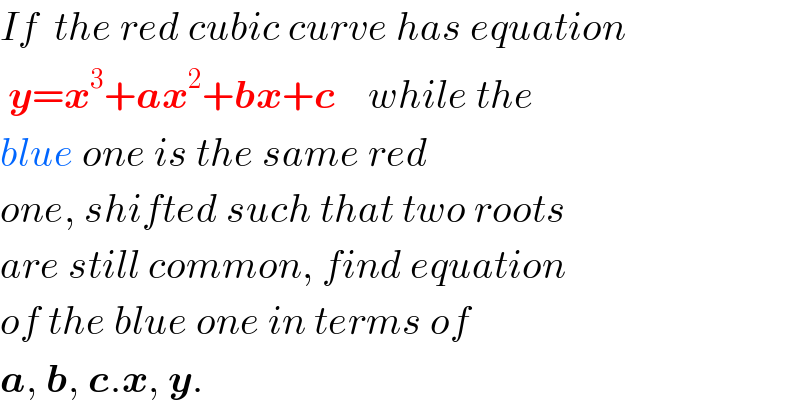
Question and Answers Forum
Question Number 91744 by ajfour last updated on 02/May/20

Commented by ajfour last updated on 02/May/20

Answered by mr W last updated on 02/May/20
![y=x^3 +ax^2 +bx+c with p=((3b−a^2 )/9) q=((2a^3 −9ab+27c)/(54)) and p^3 +q^2 <0 (such that three real roots) we get the three roots α=2(√(−p)) sin ((1/3)sin^(−1) (q/(√(−p^3 )))−((2π)/3))−(a/3) β=2(√(−p)) sin ((1/3)sin^(−1) (q/(√(−p^3 ))))−(a/3) γ=2(√(−p)) sin ((1/3)sin^(−1) (q/(√(−p^3 )))+((2π)/3))−(a/3) the eqn. of shifted cubic curve is y−k=(x−h)^3 +a(x−h)^2 +b(x−h)+c or y=(x−h)^3 +a(x−h)^2 +b(x−h)+c+k since β and γ are also its roots, (β−h)^3 +a(β−h)^2 +b(β−h)+c+k=0 ..(i) (γ−h)^3 +a(γ−h)^2 +b(γ−h)+c+k=0 ..(ii) (i)−(ii): 3h^2 −[2a+3(β+γ)]h+[β^2 +γ^2 +βγ+a(β+γ)+b]=0 ⇒h=((2a+3(β+γ)+(√(4a^2 −12b−3(β−γ)^2 )))/6) ⇒k=−(β−h)^3 −a(β−h)^2 −b(β−h)−c](Q91747.png)
Commented by mr W last updated on 02/May/20

Commented by mr W last updated on 03/May/20

